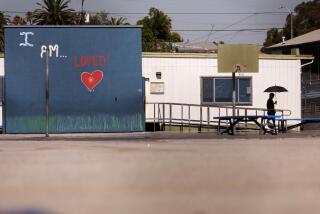The ABCs of Year-Round Schools Add Up to a Plus
- Share via
The Los Angeles school board is being asked to reconsider its decision to place all of the district’s schools on a year-round calendar by 1989. The request by member Warren Furutani, which the board will consider Monday, is illustrative of the stormy reaction to the board’s decision last week. Some people say that a year-round schedule will ruin the public school system. Others say that it makes good sense. Which view is correct?
Year-round schooling is an educational concept that eliminates the three-month summer vacation and replaces it with shorter vacation periods distributed throughout the school year. This can be done with single-track models (the entire school is on one year-round schedule) or multiple tracks (students are divided into four groups, three of which attend at any one time). In both models, students have the same amount of school and vacation time as in a traditional school year.
One common approach is a 60/20-day schedule in which students attend school for 60 days (three months) and vacation for 20 days (one month). The long summer vacation is replaced by three 20-day breaks during the year. This type of schedule (or a similar 90/30-day schedule) currently is used by hundreds of school districts across the country, with all students attending on a single track.
This type of schedule also can be used with multiple tracks in order to use classroom space at all times during the year. The multiple-track schedule increases by about 25% to 33% the number of students a school can accommodate, thus providing additional classroom space at little extra cost.
Research on the consequences of year-round schooling has identified several other advantages:
--Less time is lost in review and more time is spent on instruction. For the traditional schedule, 20 to 30 days are devoted to review at the start of the school year. For a typical 60/20 year-round schedule, only two or three days of review are needed after each break (a total of six to nine days for the year). As a result, more days are available for instruction.
--Students’ retention is greater over short breaks; they forget less.
--Student and teacher attendance rates are higher, giving students more time with the regular teacher.
Thus, year-round schools have several advantages for improving student achievement.
In addition, police report that petty crime and juvenile delinquency are reduced because there simply are fewer long stretches of time during which kids can get bored and engage in socially unacceptable behavior.
From both educational and social policy perspectives, year-round school schedules clearly have many desirable consequences.
Indeed, several California school districts that adopted year-round, multiple-track schedules to accommodate large enrollment increases shifted to the single-track year-round schedule when sufficient classroom space was constructed. In these districts families also find their favorite vacation spots less crowded during school breaks, which occur before and after the traditional summer months.
Research also shows that child-care providers and camp programs adjust to the school schedule. With most women now in the work force, child care increasingly is provided on a 12-month basis anyway.
Further, there is no research evidence that the middle class abandons a school system that adopts a year-round schedule. Indeed, as indicated above, several communities choose to retain a year-round schedule even after the enrollment-growth crunch is solved.
The Los Angeles decision to move to a year-round schedule was prompted by a large growth in student enrollment and insufficient time and funds to build enough classrooms to house them. Since 1985, the Los Angeles district has enrolled an additional 20,000 students; analysts project enrollments to increase by 10,000-12,000 annually for the next several years. Moving to a multiple-track year-round schedule in several schools helps meet the classroom shortage. Putting all schools on a year-round schedule, even if just a single track, helps to coordinate the overall school program, especially to ensure that all siblings will be on a common track.
Further, whenever the district places a school on a multiple-track year-round schedule to ease overcrowding, it receives extra state aid from a year-round school incentive program. This new money can be used to fund transitional needs and air condition schools, as well as build new classrooms.
Still, attention to several issues is required to make the transition a smooth one. First is public communication to describe the year-round schedule, its advantages and the operational details for each particular school. While much of the current outcry is understandable, accurate information and sympathetic dialogue can diminish most fears.
Second, the district must meet with the city’s Department of Parks and Recreation, the museums, the “Ys,” child-care agencies, camp operators and all other parties that typically provide “summer” and other vacation support programs and organize a shift in such programs to match the new school schedule. This cooperation is crucial to effective year-round school operations.
Third, the district must ensure that all children in one family attend on a common track and let families choose the track. In districts where this is done, most families get their first- or second-track choice.
Fourth, schools must be air conditioned; waiting another five years to air condition schools that have students attending during the summer (or, for that matter, in September and October, usually our hottest months) will only serve to increase opposition to the program.
Fifth, additional equipment and storage space for multiple-track schools is needed to make the sharing of classrooms work efficiently; where these mundane, but important, issues are not addressed, students and teachers criticize the year-round program.
In short, year-round schooling is worthy public policy on several educational and social grounds. Parents, community leaders, students, teachers and administrators should come together in support of the concept and make it work.
More to Read
Sign up for Essential California
The most important California stories and recommendations in your inbox every morning.
You may occasionally receive promotional content from the Los Angeles Times.










